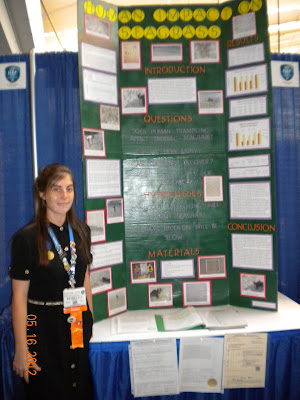 |
| Rebecca Weible, HIMB Intern at ISEF |
 |
| Counting seagrass pairs |
But getting there started the summer before in 2011, when my teacher introduced me to Mr. Heckman at Coconut Island who agreed to became my mentor for my Senior Project class at Castle High School. I had to come up with a project that I created and nurtured (with guidance), and I really wanted to do something big that would contribute to society somehow and would bring awareness to people about protecting our oceans. Mr. Heckman suggested I do my project on human impacts on seagrass, which, I have to admit did not sound very interesting at first. He introduced me to Dr. Kimberly Peyton from the Thomas lab, who taught me what seagrass is, how it benefits marine life and ecosystems. I began to get very excited.
 |
| Seagrass meadow at Moku o Lo'e, M. Heckman Photo |
 |
| Group of kayakers at HIMB beach, C. Jansen Photo |
Before I began working on this project my teacher suggested that I enter this project in the District Science Fair. I thought it was a great idea! So, I entered it and I won first place! I was so excited! Not only would I move onto State, but I would be automatically a finalist for the Intel International Science and Engineering Fair! They would pay for me to go to Pittsburgh Pennsylvania in May to compete!
 |
| Deena taking data while I do counts |
Next I plan to repeat this experiment on other seagrass meadows near the pier as well as expand my research to how different nutrients may affect seagrass growth. I also want to put up signs at the swim beach informing visitors about trampling damage. I would like to build on this project in college as well.
I want to thank everyone who helped to make this project possible and who supported me throughout the year. I can’t wait to continue this project!
Marks End Note:
As she starts her studies at UH-Manoa this fall, Rebecca also has a part time position with HCRI (Hawaii Coral Reef Initiative) and she will be back out at some point to continue the seagrass work.
We see her as one of the many that will be coming up through the expanding HIMB intern, education and citizen science programs. It reminds us that these programs do make a difference!
Aloha,
Mark
For a article on the native sea grasses at our swim beach, I am re-posting my seagrass blog from March below. For some PR on Rebecca, click to see a Midweek article "Teen Taps Science Tips From Coconut Islanders."
Thanks to Flo Thomas and her lab for supporting this work!


No comments:
Post a Comment